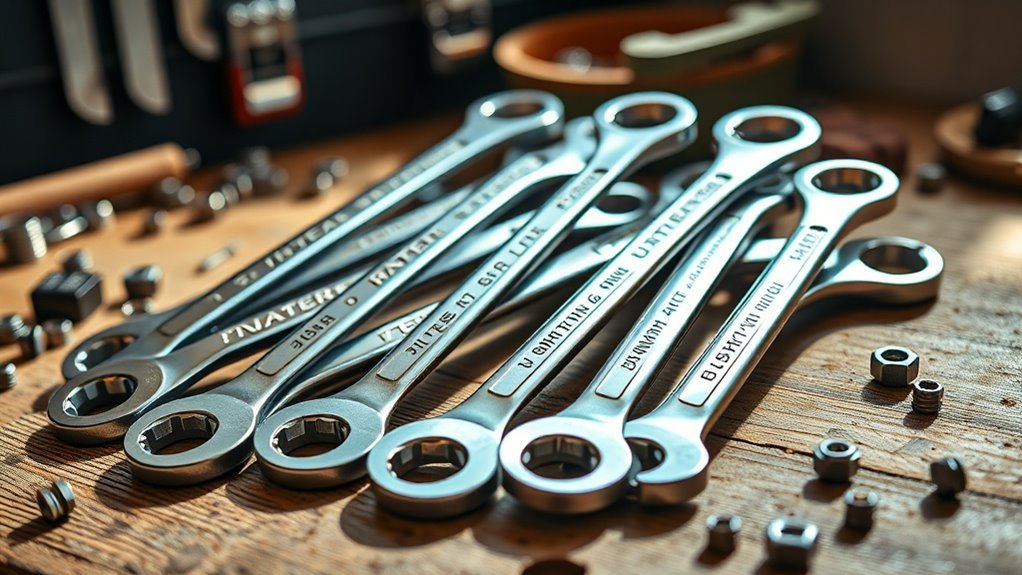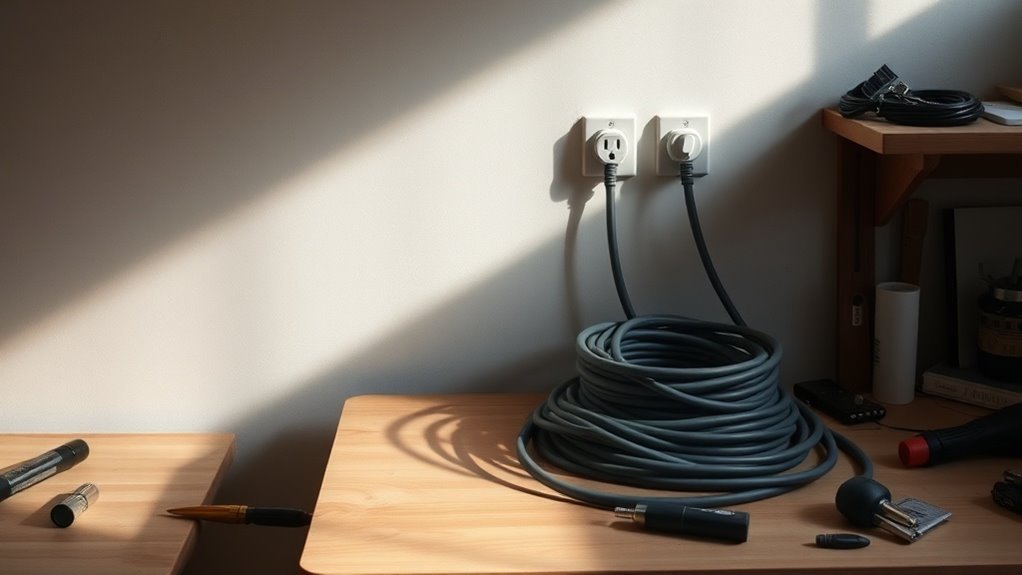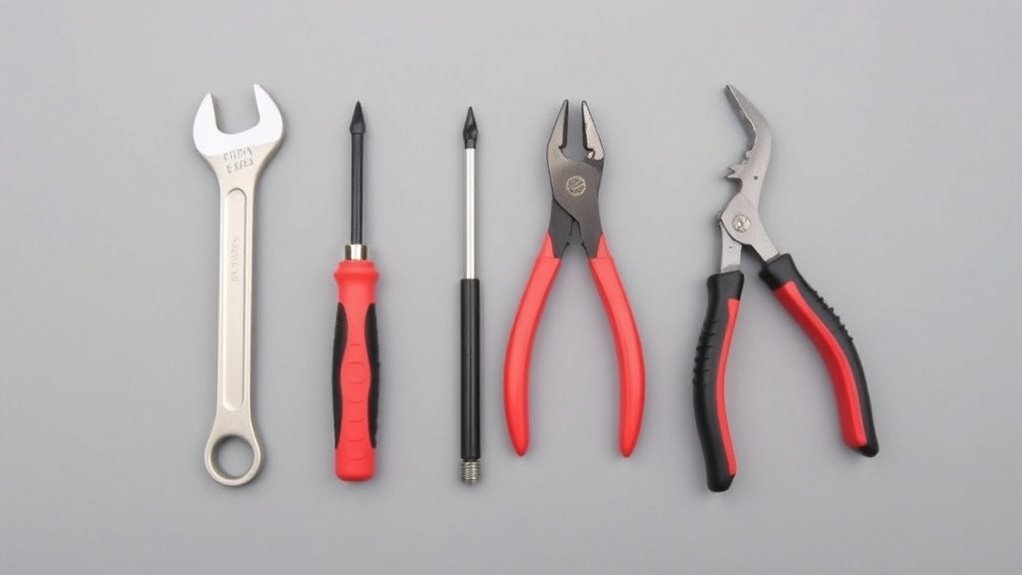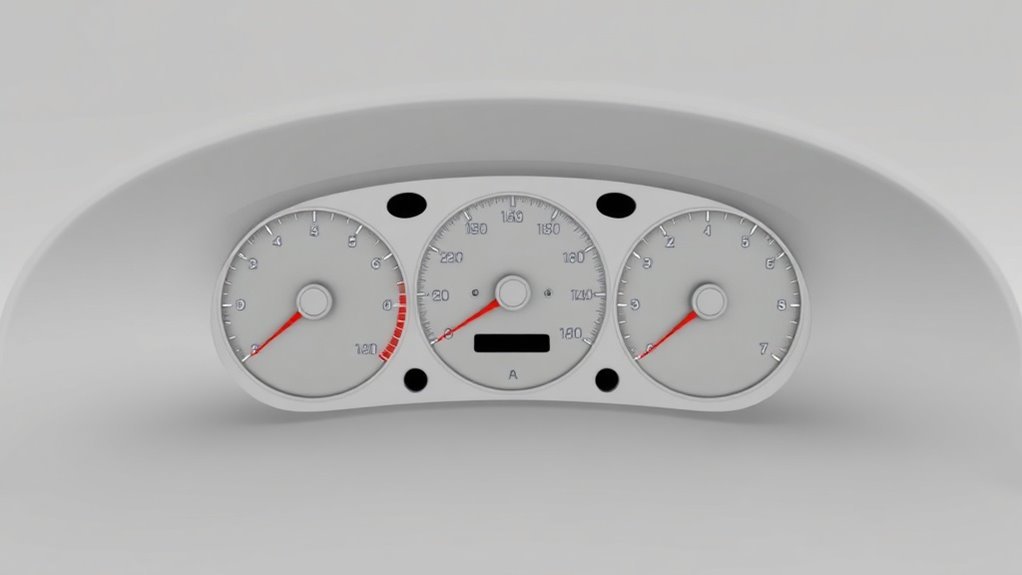Compact Design Principles in Multi-Function Tools

Compact design principles in multi-function tools enhance portability and efficiency for various tasks. These principles focus on combining functionalities into user-friendly devices that fit easily into tight spaces. Ergonomic features guarantee comfort during prolonged use, while lightweight materials improve handling without sacrificing durability. Compact folding mechanisms further streamline storage and access, making your toolbox more organized. If you’re interested in how these designs evolve and impact usability, there’s more to discover.
Key Takeaways
- Compact designs of multi-function tools minimize space requirements, enhancing portability and convenience for users on the go.
- Streamlined features reduce the need for multiple tools, allowing for efficient task management and easy access during use.
- Folding mechanisms promote compact storage, enabling tools to fit into tight spaces without sacrificing functionality.
- Interchangeable attachments increase versatility while maintaining a compact form factor, catering to diverse user needs in various situations.
- Ergonomic design elements ensure comfort and control, enhancing usability while keeping the overall size small and manageable.
Understanding Multi-Function Tools
When considering multi-function tools, it’s important to recognize their versatility in today’s toolkit. These tools combine several functionalities into a single device, making them ideal for both professionals and DIY enthusiasts.
You’ll find that many designs include features like pliers, knives, screwdrivers, and even specialized tools, all compacted into one manageable unit. This means less clutter in your toolbox and increased efficiency, as you can tackle various tasks without switching tools constantly.
Plus, their portability allows you to carry them easily on any project. Understanding how each component works together can help you maximize their potential, ensuring you get the most out of your purchase. Additionally, their design and engineering principles highlight why they are essential for streamlining tasks in various environments.
Multi-function tools are truly an essential addition to your equipment collection.
The Importance of Ergonomic Design
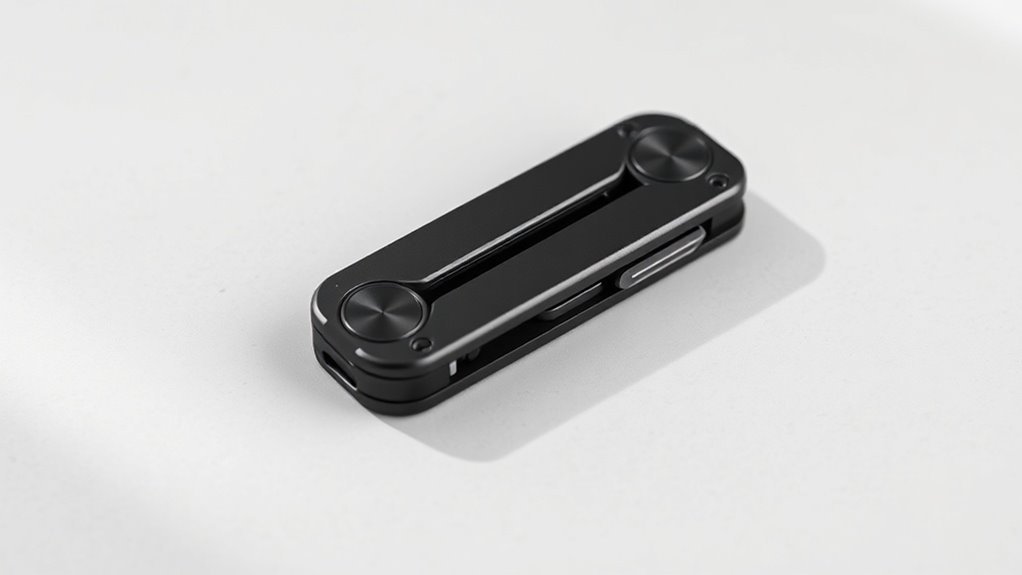
When using multi-function tools, comfort is key to ensuring you can work efficiently without strain. Ergonomic design not only enhances usability but also offers features that accommodate your natural movements. Additionally, well-designed handles can significantly minimize the risk of injury and improve overall control during use.
User Comfort Factors
Ergonomic design plays a crucial role in ensuring that you feel comfortable and capable while using multi-function tools. When these tools fit your hand and body well, it enhances your performance and reduces fatigue.
Here are three key user comfort factors to reflect on:
- Grip Design: A well-contoured grip minimizes strain on your fingers and wrists, allowing for longer use without discomfort.
- Weight Distribution: Balanced weight helps reduce the effort you need to exert, making tasks easier and more enjoyable.
- Adjustability: Tools that can adjust to different hand sizes and usage styles prevent repetitive strain injuries and cater to user preferences.
Enhanced Usability Features
How can enhanced usability features transform your experience with multi-function tools? When tools are designed with ergonomics in mind, you’ll notice a significant difference in comfort and efficiency.
You’ll find that gripping a tool feels natural, reducing strain during prolonged use. Features like textured handles and strategically placed buttons make operations intuitive, so you won’t struggle to switch functions.
Additionally, weight distribution matters; a well-balanced tool minimizes fatigue and allows for longer use without discomfort. Easy-to-read markings and adjustable components cater to your unique needs, making tasks simpler.
Ultimately, these thoughtful designs can increase your productivity and enjoyment, helping you tackle projects with confidence and ease. In the world of multi-function tools, usability is key to revealing your fullest potential.
Material Selection for Lightweight Durability
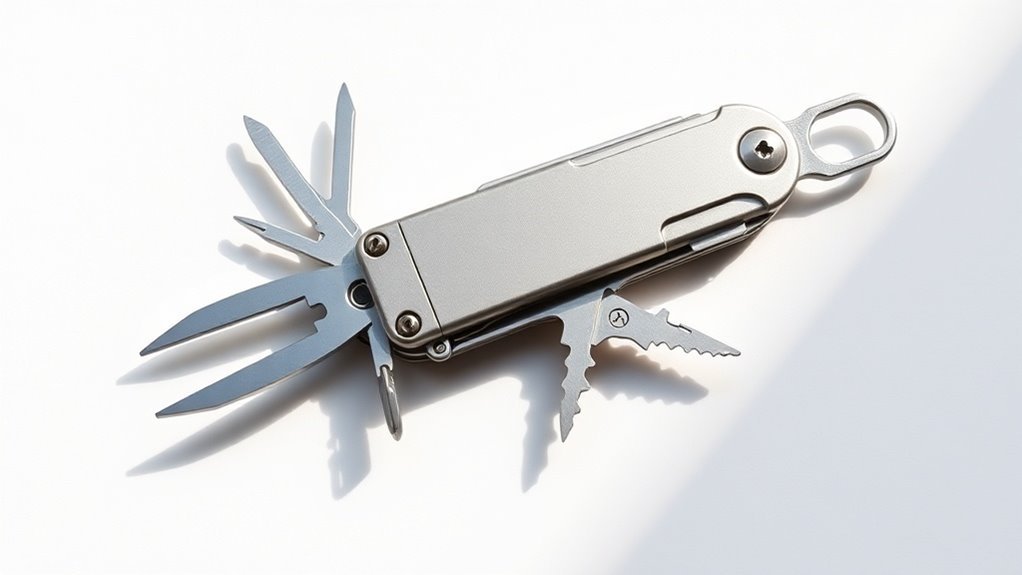
When choosing materials for multi-function tools, you’ve got to evaluate lightweight durability as a top priority.
High-strength alloys and composite materials can offer impressive benefits, balancing strength with reduced weight. Additionally, incorporating brushless motors can further enhance the performance and efficiency of these tools.
Let’s explore how these options can enhance your tool’s performance without compromising quality.
High-Strength Alloys
Selecting high-strength alloys is essential for achieving lightweight durability in multi-function tools. These materials offer a superb balance of strength and weight, ensuring your tools can endure rigorous use without excessive bulk.
When choosing high-strength alloys, consider these key benefits:
- Enhanced Strength-to-Weight Ratio: Alloys like titanium and aluminum provide high tensile strength without the heaviness.
- Corrosion Resistance: Many high-strength alloys resist environmental wear, ensuring longevity and reliability.
- Versatility in Design: Their adaptability allows for more complex geometries, making it easier to develop compact, functional tools.
Composite Materials Benefits
Many manufacturers find that composite materials greatly enhance lightweight durability in multi-function tools. These materials, like carbon fiber and fiberglass, provide exceptional strength while minimizing weight, which makes handling easier for users.
You’ll appreciate the reduced fatigue during prolonged use, thanks to their excellent shock absorption properties. Composites resist corrosion and environmental factors, ensuring your tools last without compromising performance.
You might also notice they can be molded into complex shapes, allowing for innovative designs that maximize functionality. Moreover, composite materials often require less maintenance compared to traditional metals, making them a practical choice for modern tool construction.
Streamlining Features for Maximum Versatility
To maximize versatility in multi-function tools, it’s essential to focus on streamlining features that cater to a wide range of tasks. This guarantees that you can tackle various jobs without switching tools constantly.
Here are three key features to take into account:
- Interchangeable Attachments: These allow you to customize your tool according to your specific needs, providing a solution for multiple tasks.
- Integrated Safety Mechanisms: Features like blade guards and locking systems enhance usability while keeping you safe during operation.
- Compact Storage Options: A tool that can neatly fold or shrink is easier to carry, helping you save space and stay organized.
Compact Folding Mechanisms and Their Benefits
When you consider the advantages of compact folding mechanisms in multi-function tools, it’s clear they play an essential role in enhancing portability and ease of use. These designs allow you to store tools neatly in your pocket or bag while ensuring you have everything you need at your fingertips. Plus, they often reduce weight without compromising functionality. A well-designed multitool emphasizes size, weight, and functionality to provide an optimal user experience.
Here’s a quick comparison of some benefits:
| Benefit | Description |
|---|---|
| Portability | Easily carry tools anywhere |
| Space-saving | Fits in tight storage spaces |
| Versatility | Combines multiple functions in one |
| Quick access | Fast deployment when you need it |
With these folding mechanisms, you get efficiency and practicality, making them a valuable addition to any toolkit.
User-Centric Design Considerations
Here are three key considerations:
- Functionality: Make certain the tool offers essential features that users expect, while also addressing specific tasks they often face.
- Ergonomics: Design the tool to fit comfortably in the hand. Prioritize weight distribution and grip to guarantee it’s easy to use for extended periods.
- Usability: Ensure that controls are intuitive and accessible. A user-friendly interface can mean the difference between frustration and satisfaction. Additionally, thoughtful ergonomic design principles can greatly enhance the user experience by reducing strain during prolonged use.
Future Trends in Multi-Function Tool Design
As the demand for versatility and efficiency continues to grow, multi-function tool design is evolving to incorporate advanced technologies and innovative materials. You’ll see trends focusing on lightweight designs, smart integrations, and sustainability.
| Trend | Description |
|---|---|
| Smart Technology | Bluetooth and sensors for tracking tasks. |
| Eco-Friendly Materials | Biodegradable and recycled components. |
| Modular Design | Customizable attachments for specific tasks. |
| Ergonomic Features | Improved grips to enhance user comfort. |
| Compact Folding Mechanisms | Tools that easily fit in your pocket. |
These innovations promise to enhance user experience while maintaining performance, making future tools not just multifunctional, but also smarter and more sustainable. The integration of Bluetooth and app integration will further streamline control and functionality, enhancing how users interact with their tools. Get ready for exciting changes in your toolkit!
Questions
What Are the Best Brands for Multi-Function Tools?
Some of the best brands for multi-function tools are Leatherman, Gerber, and Victorinox. They offer durability, versatility, and innovative designs. You’ll find something that fits your needs perfectly and won’t disappoint you!
How Do I Maintain My Multi-Function Tool?
To maintain your multi-function tool, regularly clean it after use, lubricate moving parts, and inspect for damage. Store it in a dry place, and keep any attachments organized to guarantee easy access and functionality.
Are There Safety Features in Multi-Function Tools?
When it comes to safety features in multi-function tools, you’re in luck! Most tools include safety guards, locking mechanisms, and anti-slip handles. Always read the manual to make certain you’re using these features effectively.
Can Multi-Function Tools Replace Traditional Tools Completely?
No, multi-function tools can’t completely replace traditional tools. They’re versatile and convenient for light tasks, but specialized tools often provide better performance and reliability for specific jobs, ensuring you have the right tool for the right task.
What Is the Ideal Size for a Compact Multi-Function Tool?
A compact multi-function tool should ideally be around 5 to 6 inches in length. For instance, the Leatherman Skeletool fits comfortably in your pocket, ensuring you have essential tools on hand without dragging you down.
Conclusion
Incorporating compact design principles in multi-function tools isn’t just about innovation; it’s about crafting a seamless user experience. By focusing on ergonomics, lightweight materials, and versatile features, these tools become like a Swiss Army knife for modern life—compact yet powerful. As you explore future trends, remember that great design marries functionality with comfort, adapting to your needs effortlessly. With the right balance, these tools can transform challenging tasks into simple, enjoyable experiences in your daily routine.


